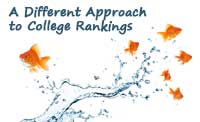 In each of my newsletters, I include a brief profile of a 50-50 college. For those new to my website, a 50-50 school is a college that accepts at least 49% of students and has at least a 49% graduation rate. I use the four-year rate for private schools and the five-year rate for public. You can download a complete list here.
In each of my newsletters, I include a brief profile of a 50-50 college. For those new to my website, a 50-50 school is a college that accepts at least 49% of students and has at least a 49% graduation rate. I use the four-year rate for private schools and the five-year rate for public. You can download a complete list here.
I have also created profiles for over 350 of them so far and am gradually getting them all listed. You can find individual profiles here. With all of the college search websites available, it wouldn’t be unreasonable for you to wonder why I bother, or more importantly, why you should bother to look at them.







